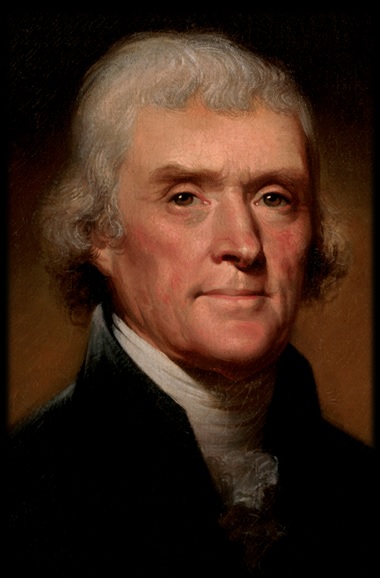
For all the accomplishments of Thomas Jefferson, and there were many, the lawyer, architect, scientist, inventor, philosopher and plantation owner whose eternal legacy memorializes him as the author of the Declaration of Independence, our nations third president had a number of skeletons in his closet.
There’s little doubt Jefferson was brilliant. On April 29, 1962, President John F. Kennedy spoke at a dinner honoring Nobel Prize Winners when he opined, “This is the most extraordinary collection of talent and human knowledge that’s ever gathered at the White House - with the possible exception of when Thomas Jefferson dined alone.”
What our 35th president didn’t mention, and likely didn’t know, was Jefferson had an ax murderer in his family and possibly sired a half dozen illegitimate children.
First the ax murderer: Charles Lilburn Lewis was born in 1747 as the oldest of eight children born to Charles Lewis and Mary Randolph. Mary’s sister was Jane Randolph Jefferson, the mother of Thomas.
On September 12, 1769, Lewis married his first cousin, Lucy Jefferson, the sister of Thomas. Like Thomas, Charles became involved in governmental affairs and accumulated a significant estate. Also, like his more famous relative, and in direct contradiction to the second paragraph of the Declaration of Independence, where Thomas Jefferson boldly declared, “All men are created equal” Charles was a slave owner. One of those slaves was a 17 year old teen named George.
December 15, 1811. Charles was hosting his brother Isham at the family home. The men had been drinking heavily when George accidently broke a vase that once belonged to their deceased mother. Charles and Isham exploded into a rage and grabbed George and tied him to the plank kitchen floor. The brothers then gathered seven other slaves and ordered them to build a large fire in the fireplace. As a terrified George begged for his life, the slaves watched in horror as Charles chopped him up with an ax.
Aghast at the murderous brutality he was witnessing, Isham tried to intercede but nearly cut himself as his brother wielded the ax like a deranged woodsman.
With George dead, Charles ordered the slaves to dismember the body and throw it into the fire. Isham watched as Charles threatened the slaves with George’s fate if they ever told. Suddenly a loud rumble overtook the cabin and the earth shifted. The New Madrid earthquake leveled the fireplace and smothered the fire. A magnitude 7.9, the quake and subsequent aftershocks still rank as the most powerful to ever strike the United States east of the Rocky Mountains.
The quake destroyed the cabin. Knowing they’d face a rope if the crime was discovered, the brothers ordered the slaves to rebuild the cabin and hide George among the reconstructed chimney. Despite their efforts, two days later an aftershock leveled the chimney and exposed George’s body parts for a dog to carry away the skull. When a neighbor discovered the canine gnawing his grisly prize, authorities were alerted. Unfortunately for Charles the skull was still recognizable and he was indicted for murder.
Shortly after being released on bail, Charles and Isham formed a suicide pact. As Charles proclaimed suicide to be a noble act for distant cousins of the great Meriwether Lewis (of Lewis and Clark) and nephews of President Jefferson, Isham developed other ideas. Soon after Charles shot himself, Isham fled. It’s believed he died during the January 1814 Battle of New Orleans.
For prospective on life in America at the time, twelve of the first eighteen US presidents owned slaves. When Jefferson drafted the Declaration he personally referred to slavery as an “abominable crime,” yet was a slave owner. So if Jefferson truly believed slavery was wrong, why didn’t he end it as president? Some historians believe Jefferson was fearful of dividing the new nation so, like other founding fathers, didn’t insist on abolishing it. It took 87 more years and a Civil War to end slavery.
Rumors that Jefferson fathered children with Sally Hemings, a Monticello slave, began during his first term as president and have remained a subject of disagreement for two centuries. Adding fuel to the fire was that Hemings's children had such light completions three of them lived in white society. According to contemporary accounts, some of Hemings's children strongly resembled Jefferson.
In January 2000, it appeared the argument would be settled. A nine member Thomas Jefferson Foundation research committee declared an analysis of DNA tests, original documents, historical accounts and statistical data indicated a high probability that Jefferson was likely the father of all six of Hemings's children.
Despite the ground breaking findings, a committee commissioned by the Thomas Jefferson Heritage Society, released a report stating they reviewed the same material and reached different conclusions - namely that Hemings was only a minor figure in Jefferson's life and that it’s unlikely he fathered any of her children. The committee also suggested Jefferson's younger brother Randolph was more likely the father of at least some of Hemings children.
Thomas Jefferson took his secrets to the grave when he died on July 4, 1826. His passing came exactly fifty years after the signing of the Declaration of Independence and hours before that of his arch political rival and our nation’s second president, John Adams whose last words were reportedly, “Jefferson lives.”
In his will Jefferson freed Sally’s children but not her. She was freed by his daughter Martha Jefferson Randolph and lived out her life with her sons in Charlottesville North Carolina.
Thomas Jefferson is buried at Monticello. His life is summarized in a stone obelisk over his grave that reads: “Here was buried Thomas Jefferson, author of the Declaration of American Independence of the statute of Virginia for religious freedom and father of the University of Virginia.” There’s no mention of him being President of the United States or being related to an ax murderer.




